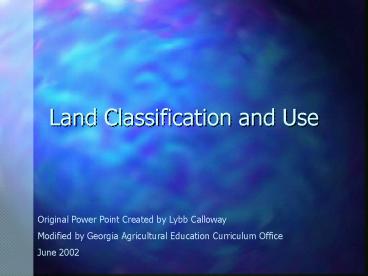Land Classification and Use PowerPoint PPT Presentation
1 / 22
Title: Land Classification and Use
1
Land Classification and Use
Original Power Point Created by Lybb
Calloway Modified by Georgia Agricultural
Education Curriculum Office June 2002
2
Land is more than soil
- Natural and artificial characteristics of an area
to be used for agricultural or other purposes - Includes renewable and nonrenewable resources
plus improvements
3
Land
- The surface of the earth not covered with water
- Maybe temporarily or permenently covered with
water - A pond for aquaculture is considered land
4
Cropland
- Used for growing crops
- Crops grown typically improve the tilth of the
land
5
Major Characteristics of Cropland
- Soil - Large impact on productivity. Soil
texture, nutrients and internal structure - Climate - average of water conditions over a long
time - Topography - form or outline of the surface of
the earth - Water supply - amount of water available for crops
6
- Subsurface conditions - Soil textures, hardpans
- Pollution - can prevent plant growth
7
Alternative Uses
- Best land use is determined by how the land will
give the most benefits to people. - Which use will give the highest returns
- What will happen if productive cropland is used
for other purposes?
8
Land Capability
- Suitability of land for agricultural uses.
- Usage should not cause damage to the land
although nutients maybe removed
9
Arable land
- Land that can be used for row crops
- Can be tilled
- Alternatives include pasture and forest crops
10
Land Improvement
- Four common practices to improve arable land
- Irrigation
- Erosion Control
- Drainage
- Forming (land forming)- surface is smoothed or
reshaped.
11
Soil Tilth
- Physical condition of the soil that makes it easy
or difficult to work - Poor tilth has hard clod
- Maybe very wet or very dry
12
Capability Factors
- Characteristics of land that determine its best
use - Surface texture
- proportion of sand, silt, clay down to about 7
inches - three major classifications
- sandy
- loamy
- clayey
13
Internal drainage
- Permeability- movement of water and air through
soil - Directly related to nutrient content
- Classified as very slow, slow, moderate and rapid
- water quickly soaks into sandy soil with high
permeability - soils with clay have slow permeability
14
Soil Depth
- Thickness of the soil layers
- Requirement depends upon type of crop to be
produced - Four soil depths are used
- very shallow - less than 10 inches
- shallow - 10 to 20 inches
- moderately deep - 20 to 36 inches
- deep - over 36 inches
- Shallow soils are often the result of erosion
15
Erosion
- Loss of topsoil by wind or other forces
- Four categories
- very severe erosion- 75 or more and large
gullies are present - severe erosion - 75 of soil has eroded but no
large gullies present - moderate erosion- 25 to 75 of soil has eroded
with small gullies present - none to slight erosion - less than 25 of soil
has eroded and no gullies are present
16
Slope
- The rise and fall of the elevation of the land
- Measured in percents
- Important in determining the best use of the land
17
Surface Runoff
- Water from rain, snow, or other precipitation
that does not soak into the ground - Can be reduced by conservation practices
- chopping stalks
- terraces
- ground cover
18
Land Capability Classes
- Assigning a number to land
- Eight classes used
- I to VIII with I being the best arability
- Class I to IV can be cultivated
- V to VIII tend to have high slope or low and wet
19
Classes
- Class I - Very good land
- Very few limitations
- deep soil and nearly level
- can be cropped every year as long as land is
taken care of - Class II - Good land
- has deep soil
- may require moderate attention to conservation
practices
20
- Class III - moderately good land
- crops must be more carefully selected
- often gently sloping hills
- terraces and stripcropping are more often used
- Class IV - fairly good land
- lowest class cultivated
- on hills with more slope than class III
- Class V - Unsuited for cultivation
- can be used for pasture crops and cattle grazing,
hay crops or tree farming - often used for wildlife or recreation areas
21
- Class VI - Not suited for row crops
- too much slope
- usually damaged by erosion with gullies
- can be used for trees, wildlife habitat, and
recreation - Class VII - Highly unsuited for cultivation
- has severe limitations
- permanent pastures, forestry, wildlife
- slope is usually over 12 percent
- large rock surfaces and boulders may be found
- very little soil present
22
Class VIII
- Cannot be used for row crops or other crops
- often lowland covered with water
- soil maybe wet or high in clay
- aquatic crops maybe grown there
- used for waterfowl habitat

